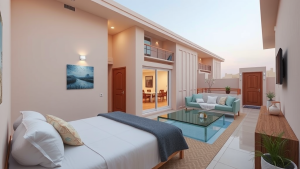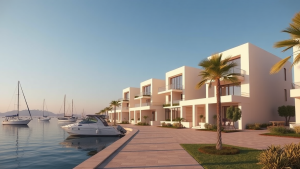Essential accessible home features for retirees to enhance safety and comfort
For retirees, home should be a place of safety and comfort as they enter a new phase of life. As mobility may decline with age, ensuring that your home is designed with accessible features can significantly impact your daily routine. There are essential home modifications that cater to your needs, allowing you to live independently and comfortably. Below are some crucial features to consider.
Step-free entrances
Having a step-free entrance is vital for easy access into your home. This feature eliminates the risk of tripping and makes it much easier to enter and exit. If modifications are needed, consider installing a ramp or ensuring doorways are wide enough for a walker or wheelchair.
Wide doorways and hallways
Accessibility also extends to the dimensions of your home. Ensure that doorways and hallways are wide enough to accommodate mobility aids. The recommended width for doorways is at least 36 inches, allowing ease of movement without obstruction.
Bathroom modifications
Your bathroom should be a safe oasis rather than a hazard zone. Here are a few modifications to consider:
- Grab Bars: Install grab bars near the toilet and in the shower to provide support during movement.
- Walk-In Tubs or Roll-In Showers: Both options allow for safe bathing without the need to step over a high bathtub wall.
- Non-Slip Flooring: Choose flooring materials that reduce the risk of slips and falls.
Kitchen accessibility
Your kitchen should be user-friendly and enable you to prepare meals easily. Consider installing work surfaces at different heights and placing frequently used items within easy reach. pull-out shelves and lazy Susans can also enhance accessibility.
Smart home technology
Smart home technologies can make daily tasks simpler. From smart lights that you can control with your voice to smart thermostats that adjust settings automatically, technology can provide convenience and enhance safety. Emergency response systems that alert family or caregivers can add an essential layer of security.
Lighting solutions
Good lighting is crucial, especially as eyesight deteriorates with age. Ensure that all areas of your home are well-lit, including staircases, hallways, and entryways. Installing motion sensor lights can be a smart choice, as they automatically turn on when someone enters a room, reducing the chance of falls.
Flooring considerations
The type of flooring in your home can affect mobility and safety. Opt for low-pile carpets or hardwood floors that are easier to navigate. Avoid slippery surfaces and ensure that throw rugs are secured or removed to prevent tripping hazards.
Furniture arrangement
How you arrange furniture plays a significant role in creating a welcoming space. Ensure that pathways are clear and that furniture is placed to facilitate easy movement. Consider using lightweight furniture that can be moved effortlessly if needed.
Emergency preparedness
Every retiree should consider emergency preparedness. Place emergency numbers, including 911 and family contacts, in visible locations. Investing in a landline phone that is easy to use or a portable alert system can also provide peace of mind.
Outdoor accessibility
Your outdoor space should be as accessible as your indoor living areas. Ensure patio or deck levels are safe and that walkways are well-maintained. Non-slip surfaces can add additional safety for outdoor areas.
Focusing on these essential accessible home features will guarantee that you can move freely and safely in your environment. By planning and making the necessary changes, you can enhance your quality of life and maintain your independence for years to come. Embrace this new chapter, making it as comfortable and enjoyable as possible.
The impact of universal design on aging in place for seniors
As we grow older, the concept of “aging in place” gains importance. Many seniors prefer to stay in their own homes, where they feel comfortable and can maintain their independence. To support this desire, incorporating universal design in the home becomes essential. Universal design is an approach that creates buildings, products, and environments that are accessible to all people, regardless of age or ability. Understanding how this thoughtful design impacts seniors can help them enjoy safer and more comfortable living conditions.
One of the key benefits of universal design is that it enhances safety. Many homes have features that can be challenging for seniors, such as stairs, narrow doorways, and slippery floors. By implementing universal design principles, you can modify your home to reduce these hazards. Here are examples of how universal design can make a big difference:
- Step-Free Entrances: Sloped walkways or ramps can replace traditional steps, allowing for easy access into the home.
- Wider Doorways: Expanding doorways accommodates mobility aids like walkers and wheelchairs, making navigation easier.
- Non-Slip Flooring: Choices like textured surface tiles or vinyl can prevent slipping, especially in areas prone to moisture, such as kitchens and bathrooms.
Another important aspect of universal design is promoting convenience. By integrating user-friendly features into the home, daily tasks become less daunting. Here are a few modifications that can help:
- Lever-Style Door Handles: These are easier to operate than traditional doorknobs. They require less dexterity and are more comfortable for seniors.
- Adjustable Shelving: Install shelving that can shift for different height needs, allowing easy access to stored items.
- Smart Home Technology: Voice-activated systems can control lighting, temperatures, and even security systems, allowing seniors to manage their home effortlessly.
Comfort is another cornerstone of universal design. Aging often comes with physical limitations, such as reduced mobility or decreasing strength. To counteract this, consider the following adjustments:
- Comfortable Furniture: Opt for furniture that offers easy sit and stand capabilities. Sofas and chairs with higher seats are easier for seniors to get in and out of.
- Accessible Bathrooms: Install grab bars near the toilet and in the shower. A walk-in shower with a bench can improve safety and comfort significantly.
- Ample Lighting: Ensure good lighting is in place throughout the home to reduce the risk of falls. Consider adding motion-sensor lights for areas that are used frequently.
Social connections are vital for overall well-being, especially for seniors. Universal design can create spaces that foster these connections by ensuring areas within the home are welcoming and accessible for families and friends. An open floor plan allows for easier movement and encourages social interaction, making it simple to host gatherings or invite visitors.
Planning for the future is imperative. Universal design not only addresses the current needs of seniors but also anticipates future accessibility requirements. A few practices include:
- Single-Level Living: If possible, convert multi-story homes into single-level designs to eliminate the challenges posed by stairs.
- Future-Proofing Features: Consider wiring for multiple future technology upgrades, like elevators, that can be installed later if needed.
- Flexible Rooms: Designate rooms that serve various purposes, such as a guest room that can later become a caregiver’s living space.
Embracing universal design in the home not only eases the aging process but also promotes independence and quality of life. Whether you are planning modifications for yourself or a loved one, doing so through the lens of universal design can make all the difference. A home designed with accessibility in mind opens doors to a fulfilling life where seniors can age in place comfortably and safely.
Making your home accessible is one of the most important steps you can take as you enter retirement. Implementing essential accessible home features not only enhances safety but also boosts your comfort and independence. Simple modifications, such as installing grab bars, using non-slip flooring, and ensuring wide doorways, can significantly reduce the risk of falls and accidents. These features make daily activities easier, allowing you to enjoy your home without the fear of injury.
Moreover, embracing universal design principles can transform your living space into a welcoming environment where you can age in place with dignity. This approach fosters inclusivity, ensuring that your home works for you now and in the future. By thinking ahead and planning for potential mobility challenges, you can create a home that adapts to your needs over time. Elements like step-free entrances, lever-style door handles, and adjustable furniture height can make a world of difference as you age.
Ultimately, investing in accessible home features and universal design is an investment in your quality of life. It allows you to maintain your independence and enjoy your retirement in the comfort of your own home. Remember, these enhancements not only serve you today but also provide peace of mind for your loved ones, knowing that you are safe and comfortable in your living space. By prioritizing accessibility, you are proactively shaping an enjoyable and fulfilling retirement experience.
16% off – studio apartments with swimming pools in Magawish Hurghada under 50k — family-friendly properties for german traders
20% cheaper – studio apartments with balconies in Arabia Hurghada under 50k — family-friendly homes for russian traders












